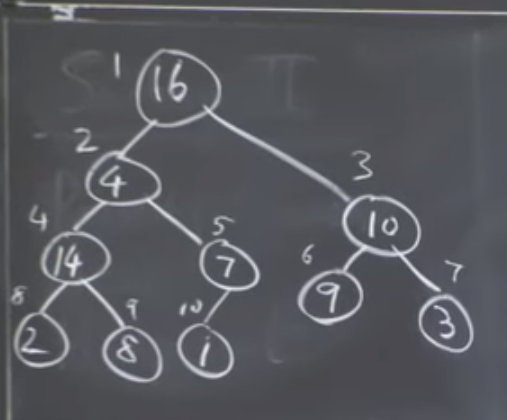MIT 6.006 Introduction to Algorithmic 01
! This is a note from MIT 6.006 Introduction to Algorithmic - YouTube
Lecture 01: Algorithmic Thinking, Peek Finding
find a peek in a Array
find a peek in a 2D Array
2022/07/24 done.
Lecture 02: Models of Computation, Document Distance
algorithm term from “al-Khwarizmi”
What’s a algorithm?
- computational procedure from solving a problem.
input->alg->output
Model of computation specifies
- what operation an algorithm is allowed
- cost (time, space …) of each operation
- Random Access Machine (RAM)
- random access memory: modeled by big array
- an algorithm in O(1) time can (# O(1) : mean constant)
- load O(1) words (# word: w bits)
- do O(1) computations
- store O(1) words
- O(1) registers
- Pointer Machine (modern language calls reference)
- dynamically allocated objects
- object has O(1) fields (# filed = word e.g. int or pointer)
Python model:
- list = array
- object with O(1) attributes
- dict get value O(1)
- long long int
- heap
Document distance problem:
- Q: d(D1, D2) (like google, wiki)
- document = sequence of words
- word = string of alphanumeric characters
- idea: shared words
- think of document as a vector, D[w] = number of occurrent of w in D
- inner product, D1.D2 / |D1||D2|
- Algorithm:
- split doc. to words
- compute word frequencies
- dot product
2022/07/27 done.
Lecture 03: Insertion Sort, Merge Sort
- why sorting?
- obverse: phone, book
- problem that become easy once items are sorted
- Finding a median
- array A [0:n] -> B[0:n]
- Binary search
- A[0:n] looking for specific item k
- compare B[0:n]
- Insertion sort
- For i = 1, 2, … n. Insert A[i] into sorted array A[0: i - 1]
- complexity: O(n^2)
- Binary Search Insertion Sort
- complexity: O(n * log(n))
- Merge sort (Divide & Conquer)
- split arrayA to arrayL and arrayR
- Merge: Two sorted arrays an input
- complexity: Theta(n * log(n)), Space: Theta(n)
- In-place merge sort (good to read paper but beyond of MIT6.006)
- Implement in others language:
- Merge sort in Python = 2.2 * n * log(n) ms
- Insertion sort in Python = 0.2 * n^2 ms
- Merge sort in C = 0.0.1 * n * log(n) ms
- so if n more than 4,000 then choose use Merge sort rather than Insertion sort
2022/08/28 done.
Lecture 04: Heaps and Heap Sort
Heap
insert(S, x): in sort element x into set S
- max(S): return element of S with the largest key
- extract-max(S): return element of S with the largest key and remove it from S
- increase-key(S, x, k): increase the value of x’s key to new value k
Heap is a Tree
- root of tree: first element (i = 1)
- parent(i) = i / 2
- left(i) = 2i
- right(i) = 2i + 1
Max-Heap
The key of a node is >= the keys of its childrenMin-Heap
The key of a node is <= the keys of its childrenHeap operations
- build_max_heap: produce a max heap from an unordered array
- max_heapify: correct a single violation of the heap property is a subtree’s root
Max Heapify
- Assume that the heap rooted at left(i) and right(j) are max heaps

- ex:
- MAX_HEAPIFY(A, 2), heap-size(A) = 10
- exchange A[2] with A[4]
- call MAX_HEAPIFY(A, 4)
- exchange A[4] with A[8]
- done
- Assume that the heap rooted at left(i) and right(j) are max heaps
Convert A[1 … n] into a max-heap
1
2
3build_max_heap(A):
for i = n/2 down to 1
do max_heapify- Observe of Max_Heapify:
- Max_Heapify taken O(1) for nodes that are one level above the leaves and in general O(
l) time for nodes that arellevel above the leaves. - n/4 nodes with level 1, n/8 with level 2, … i node log(n) level
- Total amt of work in the for loop
- n/4(1 c) + n/8(2 c) + n/16(3 c) + … + 1(log(n) c)
- Set n/4 = 2^k
- Max_Heapify taken O(1) for nodes that are one level above the leaves and in general O(
- Observe of Max_Heapify:
Heap sort (n log(n))
- Build_max_heap from unordered array
- Find max element A[i]
- Swap elements A[n] with A[i], now max element is at the end of array
- Discord node n from heap. decrementing heap size.
- New root may violate max-heap, but children are max heaps, max_heapify
2022/10/08 done.
Lecture 05: Binary Search Tree, BST Sort
- Scheduling & Binary Search Trees
- Runway reservation system
- Def n
- How to solve with arrays/lists
- Binary Search Trees operations
- Runway reservation system
- TODO